 Image search results - "shigabestmatsuri" Image search results - "shigabestmatsuri" |

The Azuchi Nobunaga Festival's main venue was here, next to Azuchi Castle (hill on right). MAP
|
|

Demonstration of matchlock guns, Azuchi Nobunaga Festival in Azuchi, Omi-Hachiman.
|
|
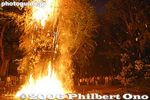
Misaki Shrine Fire Festival in Aisho. The shrine has a 5-meter tall pile of bamboo which is lit to make a towering inferno within the shrine grounds. Very dramatic. Also see the video at YouTube.
|
|
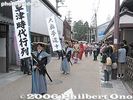
Kusatsu Shukuba Matsuri is held on April 29 to celebrate Kusatsu's history as a stage town on the Nakasendo and Tokaido Roads. The main highlight is this Kusatsu Jidai Gyoretsu procession from 11:45 am to 2 pm. This is the Tokaido Road.
|
|
|
|
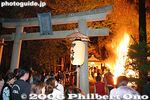
Torii at Misaki Shrine Fire Festival.
|
|

Boat ride along the moat of Azuchi Castle.
|
|

Held during Aug. 3-5 at Taga Taisha Shrine, the Mantosai or 10,000-Lantern Festival is a night festival when numerous lanterns are lit within the shrine grounds. The lanterns are for the repose of ancestral spirits.
|
|

Kusatsu Shukuba Festival, Shiga Pref.
|
|

At the foot of Azuchi, the boat ride was very popular and cheap.
|
|

Taga Taisha's lanterns come in five sizes. Each one represents a donation. The donar's name is on the lantern. The biggest lantern requires a donation of 20,000 yen.
|
|

The torches burn within seconds.
|
|

The fire at its peak was very hot to the skin. Sumiyoshi Shrine Fire Festival, Moriyama, Shiga in late Jan.
|
|

Direct path to Taga Taisha Shrine hall
|
|

Lanterns at night
|
|

Sumiyoshi Shrine Fire Festival, Moriyama, Shiga Pref. on the second Sat. of January.
|
|

Oda Nobunaga at Azuchi Nobunaga Matsuri. 織田信長
|
|
|

May 27, 2007 was a bad day for giant kite flying in Yokaichi, as the giant kite crashes head-first into a bamboo grove on its first and last flight during the Yokaichi Giant Kite Festival.
|
|

At slightly past noon with medium-force winds, the giant kite is launched. The kite immediately went straight up. The giant kite is 13 meters high and 12 meters wide, and weighs 700 kg.
|
|
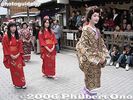
Kusatsu Shukuba Festival, Shiga Pref.
|
|

Yokaichi giant kite coming up.
|
|

Yokaichi Odako giant kite Air borne
|
|
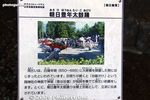
About the Asahi Honen Taiko Odori. It originated in the latter 7th century in Ohara village when they started to cultivate new farming land. It was a rainmaking dance. Now held in Oct. in Maibara.
|
|

With Mt. Ibuki in the background, the Asahi Honen Taiko Odori dance troupe head for Hachiman Shrine.
|
|

Asahi Honen Taiko Odori dancers and Mt. Ibuki in Maibara, Shiga.
|
|

Asahi Honen Taiko Odori dance in Maibara, Shiga.
|
|

Chawan Matsuri Hana-yakko flower umbrella dancers. They wear a Nagajuban kimono slip (長襦袢) and straw sandals. 花奴
|
|

The fantastic things about the festival floats is that they all have 10-meter high "balancing act" decorations depicting kabuki characters and legends. The decoration is made by a team of three craftsmen whose techniques are secret.
|
|

The floats don't look too heavy to pull at all.
|
|

Shiga governor Kada Yukiko (wearing a light green jacket on the right) pulling a festival float at the Chawan Matsuri in Yogo. The man next to her was shouting, "Banzai!" 滋賀県知事 嘉田由紀子
|
|
|

Third dance called Ogi-no-Mai (Folding Fan Dance), he holds a folding fan and a gohei sacred staff. 稚児の舞 扇の舞
|
|

On Oct. 25-26, 2008, the first Yuru-Kyara (Mascot Character) Matsuri was held on Yume-Kyobashi Castle Road in Hikone. This sign at Hikone Station points the way. Map
|
|

About 46 mascots showed up during the two days. I went on the first day. They are called "yuru-kyara" (ゆるキャラ) in Japanese which means "loose characters." (Don't ask me what that means.)
|
|

Namu-kun from Nara to celebrate the 1300th anniversary of Nara. "Namu" is based on "Namu Amida butsu" and "Namu Horengekyo." なーむくん (奈良 奈良市)
|
|

Otsu Hikaru-kun from Otsu, Shiga to promote the 1000th anniversary in 2008 of the novel Genji Monogatari written in Ishiyama-dera temple in Otsu. おおつ光ルくん (滋賀 大津市)
|
|

Humanoid mascots were the most numerous. This is Chacha-hime, based on the eldest daughter Chacha (later Lady Yodo-dono) of Lord Azai Nagamasa and Oichi (sister of Oda Nobunaga) who lived in Odani Castle in Kohoku-cho. 茶々姫
|
|

The main draw by far was Sento-kun from Nara. The place had two small stages where they introduced each mascot. A huge crowd gathered to see Sento-kun appear on stage.
|
|

Sento-kun, a boy priest with deer antlers to promote the 1300th anniversary of Nara. せんとくん (奈良 奈良市)
|
|

Hiko-nyan, the King of yuru-characters in Japan, and Tawawa-chan.
|
|

The main highlight of the festival is the Hikone Castle Festival Parade held in the afternoon of Nov. 3 (national holiday called Culture Day).
|
|

Hikone Gun Battalion dressed like Ii Clan samurai with their trademark red armor nicknamed "Red Devils."
|
|

Little Edo Hikone Castle Festival Parade
|
|

Ii Naosuke (井伊 直弼) (1815-1860) as the Tokugawa shogunate's Chief Minister (Tairo) who favored and concluded commercial treaties with the Western powers and thus broke Japan's isolation from the world.
|
|

Next are groups wearing period costumes. They are junior high schoolers.
|
|

Ii Naomasa (井伊直政) (1561-1602 ) was the first lord of Hikone from 1600. He was a general under Tokugawa Ieyasu whom he helped to win the Battle of Sekigahara in 1600. He was rewarded with the fief of Omi (now Shiga) and built Hikone Castle.
|
|

Hiko-nyan
|
|

Fireman's acrobatics is a crowd pleaser.
|
|

Before or after the castle parade, you might as well see the chrysanthemum exhibit at Gokoku Shrine (護国神社), a shrine dedicated to Shiga's war dead.
|
|

Chrysanthemum looking like Hiko-nyan.
|
|
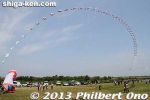
Huge arch kite of hula girls and Awa Odori dancers.
|
|
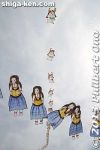
Hiko-nyan (Hikone Castle's official mascot) meets hula girls!
|
|
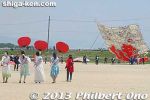
The hanjimon (判じもん) kite design always has a twin pair of creatures and a large kanji character. Together they form a thematic catch phrase.
|
|

This kite's hanjimon has twin dragons that can be pronounced "shin-shin" (辰辰), a homonym for mind and body (心身). And the vermillion kanji reads "sukoyaka" (健やか), meaning good health. So the kite wishes for your "
|
|
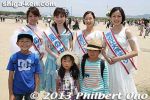
The four Wind Goddesses pose for us. The four Wind Goddesses (風の女神) are like festival princesses and they beckon the wind to blow during the kite festival.
|
|

Minami Sanno Matsuri Festival is held annually on April 4 by Hieda Jinja Shrine in Okubo and Seon (大窪、清雲). 南山王の祭 Map
|
|

Minami Sanno Matsuri Festival in Hino, Shiga.
|
|

Held annually during May 2 and 3, the Hino Matsuri is the largest festival in eastern Shiga Pref. In 2006, sixteen ornate floats and three portable shrines were paraded through the streets. It is the spring festival of the Umamioka Watamuki Shrine.
|
|

May 3, 2006: Hino Matsuri at Umamioka Watamuki Shrine 本祭(馬見岡綿向神社)Map
|
|

One by one, all the floats gather at the shrine.
|
|

Each float has a decoration on the roof depicting a popular topic during the past year. This is Yamauchi Kazutoyo and wife Chiyo from the NHK Taiga Drama called "Komyo ga Tsuji.""Komyo ga Tsuji" is about a up and coming samurai named Yamauchi Kazutoyo and his wife Chiyo who was from Shiga. The story's main setting is Shiga, and the year-long TV series was broadcast during 2006.
|
|

Ito Miki, a member of Japan's moguls team at the Turin Winter Olympics, is from Hino.
|
|

Special viewing window called "sajiki-mado" at Hino Matsuri. They view the Hino Festival procession from this special window. 桟敷窓
|
|
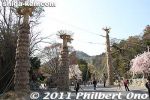
Hachiman Matsuri in Omi-Hachiman is Shiga Prefecture's biggest fire festival. Impressive even without the fire. Just look at these giant torches made of rice straw. There are more in front of Himure Hachimangu Shrine.
|
|
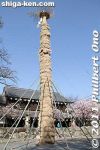
The giant torches can be as high as 10 meters. They are made on the Sunday before April 14-15 when the festival is held. So these torches have been here since Sunday. In front of Taneya.
|
|
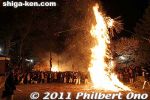
Another torch burns. One after another, they set the giant torches on fire.
|
|
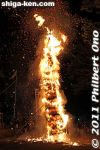
Soon the entire torch burns.
|
|

Entrance and torii to Hinade Shrine with banners announcing the sumo festival held on the third Mon. of September in Maibara.
|
|

The shrine also has a sumo ring. In the 13th century, Emperor Go-Toba visited the shrine and watched sumo performed by the local people. He offered a yellow cow to the shrine. This was the start of the shrine's annual sumo festival.
|
|
|

The winners received various household and kitchen goods like towels, pillows, toaster, etc.
|
|

It wasn't so crowded. There were some photographers, and it received local TV news coverage.
|
|
|

There is the 300-meter, pine tree-lined gravel path to the shrine from the first torii. MAP
|
|

It was a beautiful festival day on May 5, 2010. The Ayame girls wore colorful happi coats which really added color to the festival.
|
|

They leave here and proceed along the pine tree path to the first torii. Then they will come back here and go back and forth a few times during the festival.
|
|

One feature of this festival is that someone rides on the mikoshi and detaches and raised the phoenix ornament at the top of the mikoshi.
|
|
|

Ayame girls at Hyozu Matsuri in Yasu.
|
|

Held only once every 5 years, the Ibuki-yama Taiko Drum Dance was held on Oct. 3, 2010 in Ueno, a small neighborhood at the foot of Mt. Ibuki.
|
|
|
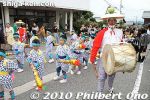
At the end of the procession are these little kids waving a wand attached to a gourd.
|
|

"Long ago, villagers in Ueno at the foot of Mt. Ibuki prayed for rain by doing the thunder dance by beating drums and bells, lighting torches, etc. After the rainfall and a good harvest in autumn, they danced to give thanks. This is what we are danci
|
|
|
|
|

Held on May 3 by Tagi Jinja Shrine (龍樹神社) in Tsuchiyama, the Kenketo Matsuri Festival is highlighted by the Kenketo Odori Dance. The road to the shrine is marked with festival banners.
|
|

Kenketo Odori is a dance performed by eight boys aged 7 to 12. The dance was originally started to ward off calamities. The boys wear tall peacock feathers on their heads.
|
|

Kenketo Odori Dance at Tagi Jinja Shrine in Tsuchiyama, Shiga Prefecture.
|
|
|

Katsube Fire Festival: Men dance in rings in front of the fire. Also see the video at YouTube.
|
|

Marker showing the way to Kaizuten Jinja Shrine on a busy highway in Makino. Kaizuten Jinja holds the annual Kaizu Matsuri (nicknamed Kaizu Rikishi Matsuri) on April 29. Rikishi means sumo wrestler.
|
|

They wear kesho mawashi ceremonial aprons normally worn by sumo wrestlers. These aprons are possessed by local families and passed down to successive generations.
|
|

They shout "Yo-ya-sa-ja!." (ヨーヤサージャー). They take several rest breaks along the way.
|
|

The Kaizu mikoshi proceeds along the shore of Lake Biwa, heading toward Kaizu.
|
|

This was the climax of the Kaizu Rikishi festival.
|
|

Held annually on April 18 by Hioki 日置神社 and Tsuno Shrines in Imazu, Takashima, Shiga, this festival features a pair of very tall (18 meters), decorated bamboo poles called O-nobori carried little by little at a horse-riding course.
|
|

Tall bamboo poles called O-nobori at Tsuno Shrine for the Kawakami Matsuri in Imazu, Takashima. They are about 20 meters tall. 大幟
|
|

Standing up the O-nobori at the Otabisho during the Kawakami Matsuri in Imazu, Takashima.
|
|

The children carried the smaller poles called ko-nobori.
|
|

Children doing the sanyare dance at the Kawakami Matsuri in Imazu, Takashima. サンヤレ踊り
|
|

Unlike the floats used in Kyoto's famous Gion Matsuri, Minakuchi's hikiyama floats are not disassembled. They are stored in their constructed state. Koka, Shiga.
|
|

By late afternoon on April 19, the festival eve, one hikiyama float arrived at Minakuchi Shrine. This is the Oike-machi hikiyama.
|
|
|

Prayer in front of the shrine by Tenjin-machi hikiyama float
|
|

Yuya-machi float has a Little Grebe duck decoration. Little Grebe is Shiga's official bird.
|
|

Maihara Hikiyama Matsuri is held annually on the three-day holiday weekend in Oct. when the second Monday in Oct. is a national holiday for Sports Day. Sunday is the main day. Poster for the Maihara Hikiyama Matsuri held on Oct. 9-11, 2010.
|
|
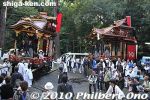
The first kabuki ended, and now they are moving out the first hikiyama float. The float behind it will be put in position for the next kabuki performance at Yutani Shrine in Maibara.
|
|
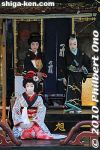
Maibara Hikiyama Matsuri in Oct.
|
|
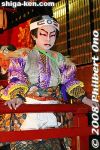
Maihara Hikiyama Matsuri, Shiga.
|
|

The festival is also called Naginata Matsuri (festival) and Naginata-furi held in Moriyama, Shiga. 長刀振り
|
|

Flower hat dancers at Naginata Matsuri, Moriyama, Shiga Prefecture.
|
|
|
|

Poster for the 2009 Nagahama Hikiyama Festival. For the basis festival schedule, also see my blog post.
|
|

The Nagahama Hikiyama Matsuri's main highlight are boys age 5 to 12 performing kabuki plays on a few ornate floats at Nagahama Hachimangu Shrine and other locations in central Nagahama. MAP
|
|

At the shrine, the kabuki play is performed one by one on the four floats, and not at the same time.
|
|
|
|
|

Kabuki performance in the shopping arcade.
|
|

Held annually on May 4 in Takashima, Shichikawa Matsuri is Oarahiko Shrine's biggest festival (Reisai). It starts with a procession in the shrine's neighborhood. The shrine is near Shin-Asahi Station (JR Kosei Line).
|
|

Shichikawa Matsuri's yakko-furi dance is a Shiga Prefecture Intangible Folk Cultural Property. 滋賀県選択無形民俗文化財
|
|

The horseback archer did not shoot any arrows. (It takes a lot of skill to do it.)
|
|
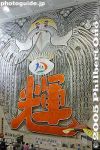
The giant kite measures about 13 high and 12 meters across, or the size of 100 tatami mats. This kite flew during 2002-2004. A new giant kite is made every three years.
|
|

The Otsu Matsuri has thirteen floats called hikiyama. Each one belongs to a different neighborhood in central Otsu. Each float has a name and features ornate carvings, tapestries, paintings, and other art work.
|
|

Karakuri puppet from Ryumon Taki-yama on display. At Otsu Station, maps and pamphlets about the festival are available.
|
|

Daytime view. The distinguishing feature of Otsu Matsuri floats is that they have three wheels instead of four (as with Kyoto's Gion Matsuri).
|
|

Otsu Matsuri floats look better at night with the lanterns lit. Seeing the festival eve is well worth it. It's not so crowded either.
|
|

Sesshoseki float at Otsu Matsuri.
|
|

Lit lanterns and lit float.
|
|

As well as Otsu Hikaru-kun, official mascot of Otsu. He is based on the Genji Monogatari (Tale of Genji) character. おおつ光ルくん
|
|

In 1596, salt vendor Jihei (塩売 治兵衛) wore a tanuki mask and danced during a Tenson Shrine festival. People liked his dancing so much that they built a float two years later and Jihei danced on it.
|
|

The Otsu Matsuri is a festival of Tenson Shrine in Otsu. The path to the shrine is packed with worshippers.
|
|

Wooden tanuki (raccoon dog) mask worn by Jihei, the man who started Otsu Matsuri.
|
|

The Omizo Matsuri is the biggest festival (Reisai) of Hiyoshi Jinja Shrine in Takashima (not to be confused with Hiyoshi Taisha in Otsu which is related) held annually on May 3-4.
|
|

May 3 is the Yoimiya or festival eve when they parade the five ornate hikiyama floats in the evening from 6:45 pm. They first gather in front of Ebisu-so, near Omi-Takashima Station. This is the Minato (湊) float.
|
|

The Takara and Tomoe floats pass by each other during the Omizo Matsuri.
|
|

All the Omizo Matsuri hikiyama arrived in succession as they ran each time. Also see my video at YouTube.
|
|
|

The second day of the Otsu Matsuri Festival is called the Honmatsuri, featuring a procession of the thirteen floats as the festival climax. The highlight are the performances by the karakuri mechanical dolls on the floats.
|
|

They also threw chimaki to the crowd. Chimaki are small bundles of straw wrapped with a thin hand towel. They were all blessed by Tenson Shrine.
|
|

The Chuo Odori road is wide, making it easy to view the floats. It's not as crowded as Gion Matsuri in Kyoto. There's a more earthly atmosphere at Otsu Matsuri.
|
|

Those people in the windows get a lot of chimaki thrown in. Otsu Matsuri.
|
|

The karakuri on Gekkyuden-yama float has two dancers, one wearing a crane crown and the other a turtle crown, dancing in front of the Emperor.
|
|

This rice paddy near the foot of Mt. Mikami and next to Mikami Shrine was used to produce the rice offering used for the Showa Emperor Hirohito's accession to the throne in 1928. Such a paddy is called Yuki Saiden. 悠紀斎田
|
|

On the fourth Sunday in May, the Yuki Saiden O-taue Matsuri, or Rice-planting Festival is held here. It starts at 10 am with a Shinto ceremony with the planters and local dignitaries in attendance in front of the rice paddy.
|
|

This rice paddy was used to produce the rice used for a ritual called the Daijosai as part of the Showa Emperor's accession ceremonies in 1928. Selected by the Imperial Household Agency, the Yuki Saiden sacred rice paddy must be east of Kyoto. 悠�
|
|

They wear a sedge hat (suge-kasa すげ笠), red trousers (緋ばかま), wrist covers (手甲), and leggings (脚絆).
|
|

Rice-planting Festival in Yasu, Shiga Prefecture with Mt. Mikami in the background. Also see my YouTube video here.
|
|
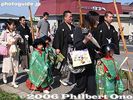
Nabe-kanmuri Matsuri procession held on May 3 by Chikuma Shrine, Maibara, Shiga Pref.
|
|

Girl with nabe-kanmuri helmet, Nabe-kanmuri Matsuri, Maibara, Shiga Pref. Known as one of Shiga's more unusual festivals.
|
|

The main path to Suginoki Shrine in Ryuo where the Kenketo and naginata procession will come through. The Kenketo Matsuri festival is held annually on May 3. It features the naginata dance and more.
|
|

On the day of the festival on May 3, the Kenketo and naginata dance are held at multiple shrines in the area including neighboring Higashi-Omi. This is Higashi Hiyoshi Shrine (short walk from Suginoki) where a kenketo procession was to arrive and dance.
|
|
|
|
|

Naginata Odori in Ryuo. 長刀仕舞振り(長刀芸)
|
|

On the grounds of Shinoda Jinja Shrine is this large wooden panel with a large design. It is about 15 meters high and 20 meters wide. Held annually on May 4 at Shinoda Shrine, the Shinoda Hanabi display is a surprisingly spectacular fireworks display.
|
|

Shinoda Fireworks
|
|

Shinoda Fireworks climaxed with an incredible spectacle of sight and sound. The ancient Japanese sure knew how to make and show fireworks.
|
|

Shigaraki Fire Festival: Burned hot and high. It got quite hot even at this distance. I thought my camera would melt.
|
|

They all carry the torches on their shoulders.
|
|

First they go along the main street toward Shigaraki Station. In the background is a Shigaraki pottery shop.
|
|
|

Held during the weekend in mid-March, the Sagicho Matsuri is a dramatic parade and clashing of 13 or 14 colorful Sagicho floats. On the first day at 1 pm, 14 Sagicho Festival floats gather at Himure Hachimangu Shrine near Hachiman-bori Canal.
|
|

From 2 pm, the procession starts and the floats start to exit the shrine. Also see the video at YouTube.
|
|

By now, you will notice that the tanuki (racoon dog) is the symbol of Shigaraki. This giant tanuki greets you at Shigaraki Station. Wish they removed that pay phone.
|
|

On the first day (Sat.), the floats are paraded along the streets near the shrine and undergo judging for best design. The floats are works of art and made of edible materials mounted on a straw and wood base all to be set afire in the end.
|
|

Dai-niku float in front of Hakuunkan, a classic Western-style building, now a tourist info office and exhibition gallery. Also see the video at YouTube. Sagicho Festival, Omi-Hachiman. 第二区
|
|

Similar to the beckoning cat, the Shigaraki tanuki is a common good luck charm placed at the entrance of homes and shops. Tanuki of all sizes for sale year round.
|
|
|
|

The tanuki have different faces and doing different things, even karaoke. Didn't see any looking like a photographer though.
|
|

Tanuki faces. This one is probably the most typical in the modern age.
|
|

On the second day of the festival, the floats clash with each other. Sagicho floats pass through the torii of Himure Hachimangu Shrine, near Hachiman-bori Canal.
|
|

When I visited in mid-Oct., the Shigaraki Ceramic Cultural Park was holding the Ceramic Art Market. Notice the tents for the ceramic artists selling their works.
|
|

The Ceramic Art Market in Shigaraki Ceramic Cultural Park has ceramics artists having their own booth to sell their wares.
|
|
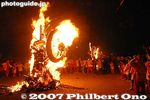
At this stage, the fire is quite hot. Sagicho Matsuri, Omi-Hachiman
|
|

One of Otsu's Big Three Festivals, the Senko-sai is a portable shrine procession on boats going down Seta River from Seta-no-Karahashi Bridge to Nango sluice and back. Held annually on Aug. 17 by Takebe Taisha Shrine. The festival starts at 5 pm.
|
|

The Senko-sai festival personifies the marine journey of legendary prince and warrior Yamato Takeru. It also prays for water safety. Yamato Takeru is one god Takebe Taisha Shrine worships.
|
|
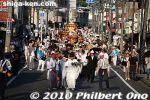
The festival started at 5 pm when the mikoshi (portable shrine) procession departed Takebe Taisha Shrine about 500 meters from the east end of Seta-no-Karahashi Bridge.
|
|
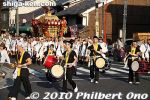
Escorted by taiko drummers, the main mikoshi arrives at the east end of Seta-no-Karahashi Bridge.
|
|
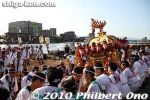
Hauling the main mikoshi onto the boat.
|
|
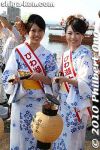
The two Biwako Otsu Tourist Ambassadors for 2010, Inoue Madoka and Nagata Megumi. Selected from among 21 applicants in April 2010. For one year, their job is to promote tourism in Otsu. びわ湖大津観光大使:井上まどか、永田めぐみ
|
|
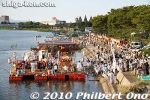
Boat pier north of the east end of Seta-no-Karahashi Bridge. This is where the crowd was concentrated. People gave a few speeches before the boats left.
|
|
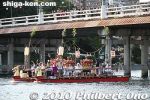
Boat with the three portable shrines pass under Seta-no-Karahashi Bridge.
|
|

The Sanno-sai Festival is held annually on April 12-15 at Hiyoshi Taisha Shrine in Otsu, Shiga Prefecture. Not to be confused with the Sanno Matsuri held by Hie Shrine in Tokyo. It centers on April 14, the shrine's most important day called Reisai.
|
|

Hiyoshi Taisha is at the foot of Mt. Hiei (home of Enryakuji temple) and it worships the mountain god. The Sanno-sai festival is the shrine's biggest festival and one of Shiga's biggest festivals. MAP
|
|

The Sanno Festival (in Japanese it's called Sanno-sai, not Sanno Matsuri) consists of a myriad of festival events. Also interesting is the participation of Buddhist priests from Enryakuji temple atop Mt. Hiei.
|
|

THe Flower Procession is held to celebrate the birth of the shrine's child god. Therefore, this event centers on the parent-child connection.
|
|

Torch bearers arrive at the Yomiya-jo while running.
|
|
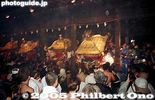
All four groups of men then rocked the mikoshi back and forth. making thunderous noise. Very dramatic. This is called Yomiya Otoshi. 宵宮落し神事
|
|

Next day on April 14, the Reisai day, the schedule is filled with more ceremonies and events. At 10 am, the Reisai ceremony is held at Nishi Hongu with the Tendai Zasu Abbot from Enryakuji in attendance. He is under the red umbrella.
|
|

The Tendai Abbot leaves Nishi Hongu in a procession of Buddhist priests.
|
|

Sanno-sai Festival, Hiyoshi Taisha Shrine, Otsu, Shiga Prefecture
|
|

Barge loaded with mikoshi approaching Wakamiya Port. Sanno-sai Festival.
|
|

Route taken by the Saio princess from Kyoto to Saiku Palace, near Ise Grand Shrines. The journey took 5 nights and 6 days, and passed through Shiga at Seta (Otsu), Kafuka (Koka), and Tarumi before going to Mie at Suzuka and Ichishi. The Saio princess stayed at a different palace each night, and three of them were in Shiga. The temporary palace for the Saio princess was called Tongu (頓宮). Only the Tarumi Tongu's former location is known today.
|
|

The Saio princess was an unmarried, young Imperial princess, often the Emperor's daughter, who was appointed (by divination) to be the High Priestess of Ise Grand Shrines in Mie Prefecture from the 7th to 14th centuries.This Ai-no-Tsuchiyama Saio Princess Procession was started in 1998.
|
|

For about 660 years from the 7th century, over 60 Saio princesses served at Ise Grand Shrines. Each time there was a new emperor, a new Saio princess would be appointed to serve at Ise.
|
|

The new Saio princess traveled from Kyoto to the Saiku palace near Ise Grand Shrines. It took 5 nights and 6 days. From 886 to 1264 (378 years), one stop along the way was Tarumi Tongu in Tsuchiyama.
|
|

This festival reenacts the Tsuchiyama leg of the Saio Princess Procession. It started at Ono Elementary School and proceeded to the site of Tarumi Tongu, one of the five temporary palaces for the Saio.
|
|

Saio princess of the Ai-no-Tsuchiyama Saio Gunko Matsuri festival in March.
|
|

Saio princess in Tsuchiyama, Koka.
|
|

Shimoniikawa Shrine, site of the Sushikiri (sushi-cutting) Festival on May 5. The shrine is a 20-min. bus ride from Moriyama Station. 下新川神社 MAP
|
|

The festival got its start when the legendary Toyoki-iribiko-no-Mikoto crossed Lake Biwa from the west shore to Moriyama on a log raft to subjugate the eastern provinces. A local villager then offered him pickled carp caught in Lake Biwa as an offering.
|
|

How spectacular can a pair of boys be, cutting up a fish? This festival always receives a lot of publicity on TV and newspapers, but I didn't see that many people attending. Not so many photographers either, although NHK TV was standing next to me.
|
|

Due to financial reasons, the Suijo Hachiman Shrine Taiko Drum Dance is held only once every 5 years. I went to see it on Sept. 23, 2009. MAP
|
|

In a local community center in Suijo, they started at 6 am to paint the bellies and thighs of 15 men called yakko. Yakko were manual laborers employed by the samurai. They carried luggage during trips, etc.
|
|

Tiger man.
|
|

Yakko men carried some luggage and sometimes passed it on to other men. This is Suijo's main road.
|
|

There were about 50 taiko drummers. They also practiced every day during summer vacation. The boys drummed, while the girls played the flute.
|
|

The taiko drum dance started as a rainmaking dance in 1671 during a drought. The dance continued until 1947. In 1965, they revived the dance, but held it only once every 5 years due to the cost.
|
|

The next time this taiko dance will be held will be in Oct. 2014. However, a similar taiko drum dance will be held in Oct. 2010 in neighboring Ueno at Sannomiya Shrine at the foot of Mt. Ibuki.
|
|

Suijo Hachiman Shrine Taiko Odori dance in Maibara, Shiga.
|
|

Sakata Shinmeigu Shrine, near JR Sakata Station on the Hokuriku Line. The site of the annual Yakko-buri Procession held on April 29. I saw it in 2010. MAP
|
|

Reenacts the daimyo procession of Lord Ii Naonobu from Hikone when he came to worship at Sakata Shinmeigu Shrine in 1733 in Maibara.
|
|

Sakata Shinmeigu Shrine Yakko-buri, Maibara, Shiga
|
|
|

Taga Taisha Shrine's torii is festooned with red banners reading " Taga Taisha O-taue Matsuri" or Rice-Planting Festival. Held on the first Sunday in June at 1 pm at the shrine. MAP
|
|

The 70 rice planters are junior high school girls in colorful costumes. They are called Taume. 田植女
|
|

Oyushiki ceremony is performed to purify the sacred rice paddies during the Taga Taisha Rice-Planting Festival. 御湯式
|
|

O-taue odori dancers
|
|

Taume rice-planting girl at Taga Taisha Rice-planting Festival, Shiga Prefecture.
|
|

Nearing the end. However, they did not finish planting the entire paddy. They ended the festival at around 3 pm even though three of the four paddies were still unfinished.
|
|

Giving New Year's prayers at Taga Taisha shrine.
|
|

Dance by shrine maidens on New Year's Day 2005 at Taga Taisha Shrine.. Also see the 2005 video at YouTube.
|
|

Taga Matsuri is held annually on April 22 at Taga Taisha Shrine. It's basically a procession of Shinto priests, children in costume, women warriors, and other people on 40 horses. These photos were taken in 2009.
|
|

Girls dressed as shrine maidens pose for a picture. They will join the afetrnoon procession and perform a sacred dance at the Otabisho.
|
|
|

Taga Matsuri Festival on April 22, Shiga Prefecture. 多賀まつり
|
|

Woman warrior on horseback for the Taga Matsuri, Shiga Prefecture. 女武者
|
|
|
|

Good-looking woman warrior on a horse, Taga Matsuri, Shiga Pref.
|
|

Burning old New Year's decorations, Hokoku Jinja, Nagahama, Shiga Pref.
|
|

Taga Taisha Shrine's Setsubun bean throwing on Feb. 3 (at 10:30 am and 1:30 pm) is perhaps Shiga's most prominent with three impressive demons (called oni) on stage acting as the evil oni to be chased away with soybeans.Feb. 3 is the Setsubun Festival at many temples and shrines in Japan. It marks the beginning of spring according to the lunar calendar. So they throw beans at ogre to eliminate the evil of the previous year and bring in good fortune.
|
|

The oni first appeared amid smoke on the Kaguraden stage and danced menacingly. They were from a dance troupe called Inbara Kaguradan in Shimane Prefecture. 鬼の舞は、島根県石見地方の因原(いんばら)神楽団が奉納。Taga Taisha had impressive ogre (called oni in Japanese) dancers from Shimane Prefecture to act as the demons to chase away during the festival.
|
|
|

The bean-throwing was fun, but potentially dangerous with people pushing you around. Taking pictures is pretty risky as well. One mochi hit my camera lens. Fortunately, no damage.
|
|

Kobiyoshi Shrine in rural Ryuo holds the Yuge no Hi Matsuri fire festival on the evening of May 1. See small torches, tossing flares, lots of firecrackers, fireworks, two giant straw torches. 弓削の火祭り MAPFrom Omi-Hachiman Station No. 4 bus stop, board the bus for Okaya Minami and get off at Nishikawa Higashi-guchi bus stop. The ride is about 13 min. From the bus stop, the shrine is a 10-min. walk. You can also take a taxi from Omi-Hachiman Station. Taxi would be required on the way back to Omi-Hachiman since the buses will not be running after the festival is over.
|
|

Yes, it's Doraemon as fireworks. This lasted briefly before it snuffed out. I heard that they have this every year for this Yuge Fire Festival.
|
|

At the same time as Niagara Falls, they lit the two giant torches. It was hard to watch both the Niagara Falls and giant torches at the same time. But Niagara soon petered out.
|
|
|
|
|
|